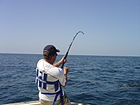| Revision as of 15:17, 16 January 2014 editMike Cline (talk | contribs)Administrators53,120 editsNo edit summary← Previous edit | Revision as of 11:46, 31 July 2016 edit undoMagioladitis (talk | contribs)Extended confirmed users, Rollbackers908,576 editsm clean up / fix section header naming (WP:ASL) using AWB (12061)Next edit → | ||
| Line 4: | Line 4: | ||
| The Cosseboom was originally tied with an olive green body, silver tinsel ribbing, grey squirrel tail wing, and a lemon-yellow ] tied as a collar after the wing was applied, with a red head. Other body and hackle color combinations have evolved, but all retain the grey squirrel tail wing. The Cosseboom remains a very popular and effective Atlantic salmon fly and is used worldwide. | The Cosseboom was originally tied with an olive green body, silver tinsel ribbing, grey squirrel tail wing, and a lemon-yellow ] tied as a collar after the wing was applied, with a red head. Other body and hackle color combinations have evolved, but all retain the grey squirrel tail wing. The Cosseboom remains a very popular and effective Atlantic salmon fly and is used worldwide. | ||
| == |
==Sources== | ||
| *''Atlantic Salmon Flies & Fishing'', pp. |
*''Atlantic Salmon Flies & Fishing'', pp. 235–239, by Joseph D. Bates, Stackpole Books, Harrisburg, Pennsylvania, 1970. | ||
| ==External links== | ==External links== | ||
| * | * | ||
| ⚫ | {{fishing-stub}} | ||
| {{angling topics|expanded=fly fishing}} | {{angling topics|expanded=fly fishing}} | ||
| ] | ] | ||
| ⚫ | {{fishing-stub}} | ||
Revision as of 11:46, 31 July 2016
| This article does not cite any sources. Please help improve this article by adding citations to reliable sources. Unsourced material may be challenged and removed. Find sources: "Cosseboom" – news · newspapers · books · scholar · JSTOR (July 2012) (Learn how and when to remove this message) |
Cosseboom is a type of artificial fly, commonly used in fly fishing to catch salmon. It was created by the American angler John C. Cosseboom of Woonsocket, Rhode Island in around 1923, for use on the Margaree River in Nova Scotia, Canada.
The Cosseboom was originally tied with an olive green body, silver tinsel ribbing, grey squirrel tail wing, and a lemon-yellow hackle tied as a collar after the wing was applied, with a red head. Other body and hackle color combinations have evolved, but all retain the grey squirrel tail wing. The Cosseboom remains a very popular and effective Atlantic salmon fly and is used worldwide.
Sources
- Atlantic Salmon Flies & Fishing, pp. 235–239, by Joseph D. Bates, Stackpole Books, Harrisburg, Pennsylvania, 1970.
External links
This fishing-related article is a stub. You can help Misplaced Pages by expanding it. |

